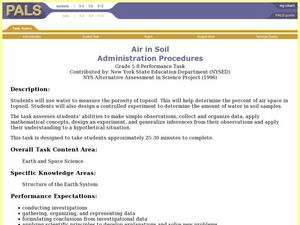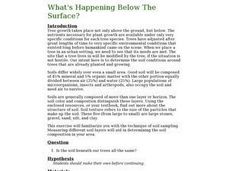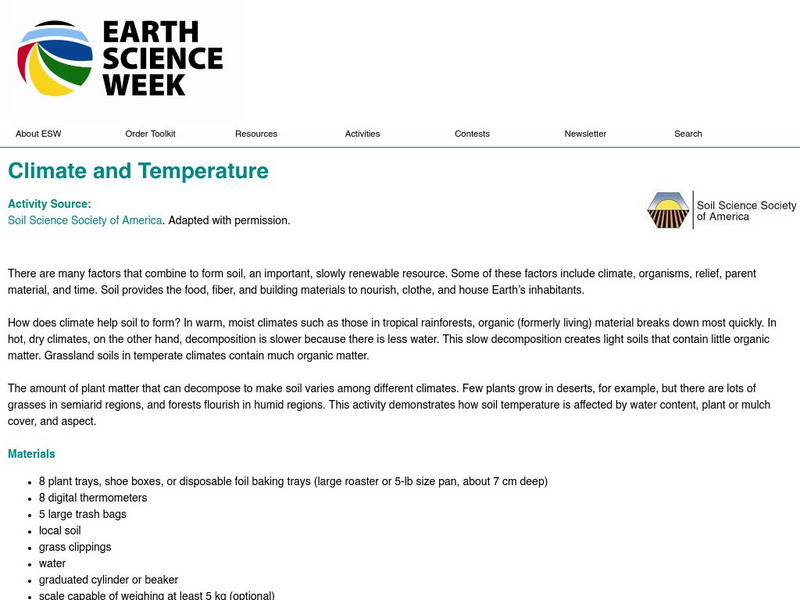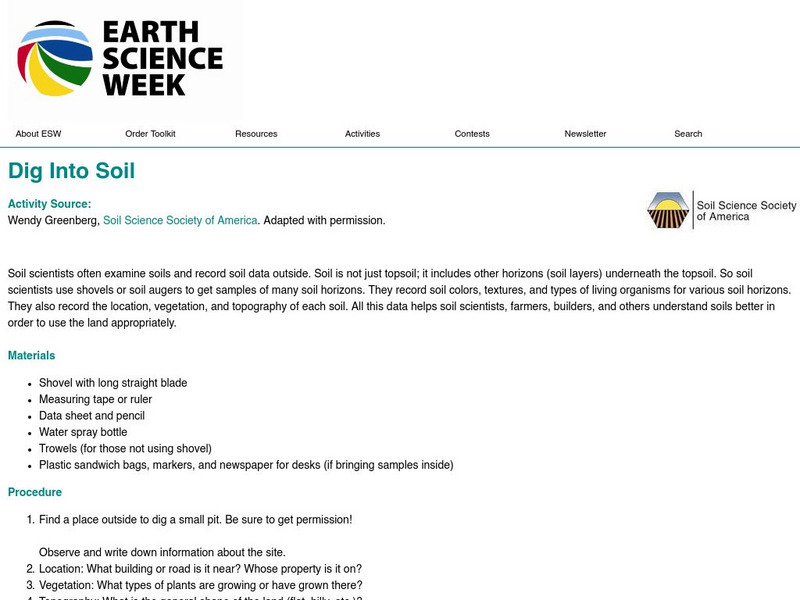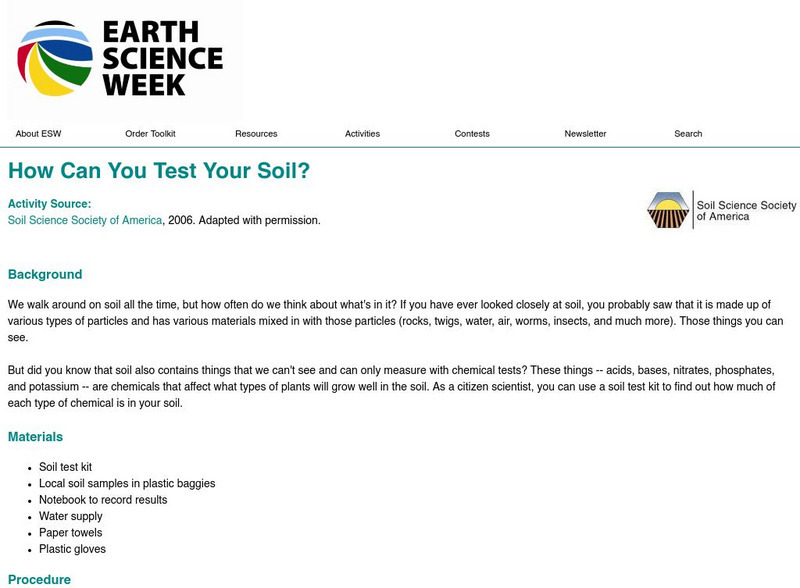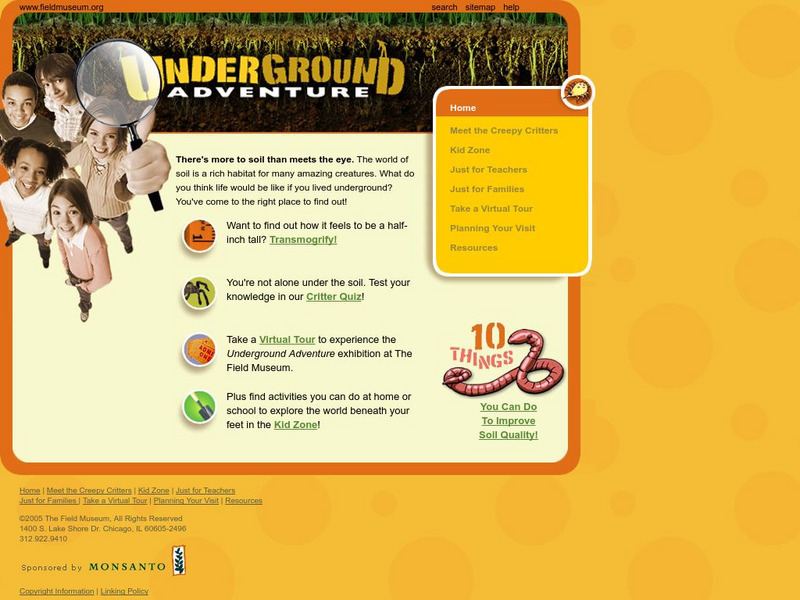Curated OER
Air in Soil Administration Procedures
Students study soil and its composition. In this soil composition lesson, students study examples of soil during several days of aeration. Students summarize their data, organize it, and must be able to explain their findings.
Curated OER
Soils are the Pits!
Students dig soil pits in order to observe soil features and the factors of soil formation and soil forming process. Students also examine the relationships among different soils in a series of soil pits.
Curated OER
What's Happening Below The Surface?
Pupils determine the soil composition of soil layers in their area. They collect soil samples, calculate the percentage soil water content, analyze data, and evaluate each site for future tree growth.
Curated OER
Soil Composition
Students investigate how soil composition affects plant growth. In small groups, they plant various seeds in different soil mixtures, record plant and seed growth, and analyze the results.
Science Buddies
Science Buddies: Career Profile: Soil Scientist
Soil scientists are interested in soil not just for agricultural purposes, but also for construction conditions. Read about the career and employment opportunities for soil scientists in this Science Buddies career profile. Find out the...
Curated OER
Bureau of Land Management: Just for Kids: Soil Biological Communities
This engaging site about soil is easy to understand and filled with quick facts. Cartoon graphics and menu tabs highlight topics which include the importance of soil, fast facts, soil critters, food webs, and others.
TeachEngineering
Teach Engineering: Shallow & Deep Foundations
Students investigate the critical nature of foundations as they learn differences between shallow and deep foundations, including the concepts of bearing pressure and settlement. Using models representing a shallow foundation and a deep...
Discovery Education
Discovery Education: The Dirt on Soil
This interactive website explores the various soil layers and introduces you to the lifeforms that live in those soil layers.
Science Education Resource Center at Carleton College
Serc: Determining the Density, P H and Water Content of Various Area Soils
In this chemistry field lab, students will determine the density, pH, and water content of 4 types of soil. Students compare class data and write a lab report describing their results and then analyze their findings to report on the...
Science Education Resource Center at Carleton College
Serc: Comparing Soil Samples From Different Locations
In this field investigation, students compare various soil samples taken from specific locations. Students compare samples, record data, create a chart or graph, and keep records in a journal.
Science Education Resource Center at Carleton College
Serc: Investigating Soil Composition Soil Soaks Up Water
In this classroom activity, students will show how soil composition affects the amount of water the soil holds. They will test sand and soil independently and then create their own mixture.
Science Education Resource Center at Carleton College
Serc: Investigating Soil Which Soil Help Plants Grow?
In this guided inquiry lab, students will investigate what type of soil let plants/grasses grow the best. Students will answer the question by conducting an experiment using five different soils found in our area, school soil, potting...
Science Education Resource Center at Carleton College
Serc: Investigating Soils
In this guided inquiry students will specify soil types by using various methods of determining soil textures and analyze them with a soil triangle. This activity is a laboratory investigation where students gather data on soil textures,...
University of Wisconsin
Geography 101: Soil Characteristics
By the end of this unit you should be able to: list the seven characteristics used to describe soils, to distinguish one soil from another soil, and to distinguish one soil layer from another soil layer; explain the impact of soil...
Other
Pipeline: Soil Characteristics Demystifying Dirt [Pdf]
Soil is the foundation of conventional on site wastewater treatment.The drainfields used with on site systems work because the soil around the trenches acts as a filter and removes organic matter, some of the nutrients present in...
American Geosciences Institute
American Geosciences Institute: Earth Science Week: Mapping Your Soil
Use the Web Soil Survey developed by the USDA-Natural Resources Conservation Service to determine what soil is around your school and how it can be used.
American Geosciences Institute
American Geosciences Institute: Earth Science Week: Soil Moisture
This set of activities introduces students to the basic properties and measurements of soil water, and how the global distribution of soil moisture is monitored.
Other
Physical geography.net: Introduction to Soils
A detailed primer on the composition of soil, its color, pH, texture, and its profile.
American Geosciences Institute
American Geosciences Institute: Earth Science Week: Climate and Temperature
In this experiment, students investigate what impact the composition of soil, its water content, and its location have on the soil's temperature, which in turn would have an effect on the rate of decomposition of organic matter in the soil.
American Geosciences Institute
American Geosciences Institute: Earth Science Week: Dig Into Soil
In this activity, students examine soil. They choose a location and describe it. They then dig a hole, measure the depth of the topsoil and subsoil, take samples of each, and describe their composition and characteristics.
American Geosciences Institute
American Geosciences Institute: Earth Science Week: How Can You Test Your Soil?
As a citizen scientist, students use a soil test kit to find out how much of each type of chemical is in the local soil.
The Field Museum
Field Museum: Exhibits: Underground Adventure
The Chicago Field Museum provides a comprehensive soil education project covering topics such as soil structure and organisms living underground. Students can use the site for research or do the full-blown project, where they establish a...
Other
Agronomy: Soil Formation [Pdf]
Soils may be formed in place from rock or formed in weathered rock and minerals that have been transported from where the original rock occurred.
NASA
Nasa: What's the Scoop on Soil?
A brief summary on the importance of soil, its' origin and composition.


